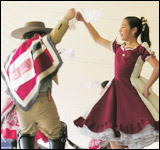Numbers in Spanish
This free audio lesson is all about numbers in Spanish. Learn how to say Spanish numbers from 0 to 1,000,000! Learning your numbers in Spanish is an essential part of the language.
How to pronounce numbers in Spanish (0 - 35)
Important! Perfect Your Pronunciation With Rocket Record
Ready to Start Learning Spanish?
Masculine and Feminine Numbers in Spanish
You don’t have to worry about gender with Spanish numbers 90% of the time. However, if you are talking about one thing, or are using a number that ends in one, you need to change the ending to reflect the gender of the noun that the number is describing.
If a number ends in one, change the ending according to whether or not the number is referring to a masculine or feminine noun. (The ending will only change according to gender, not by whether the noun is singular or plural.)
• un for masculine, e.g. un perro "one dog," un año "one year," un lápiz "one pen"
• una for feminine, e.g. una vaca "one cow," una flor "one flower," una chica "one girl"
Por ejemplo:
1. Eduardo tiene treinta y un años de edad. "Edward is 31 years old."
2. Necesito veintiuna invitaciones más. "I need 21 more invitations."
However, if you want to talk about the number one (or 21 or 31) on its own (i.e., as a numerical term rather than a quantity), you will not have to worry about gender. You will simply use uno. For example, if you want to say that 20 + one = 21, you will say:
- Veinte más uno son veintiuno. "20 + one = 21."

Spanish Numbers from 36 to 102
Important! Remember What You Learn
Once you master the basic pattern, you can construct any number. For example, how would you say 135? Simply remember: 135 = 100 + 30 + “and” + 5.
- Ciento + treinta + y + cinco = ciento treinta y cinco
Although the number 100 is cien, any number between 101 and 199 starts with ciento.
- 199 = ciento + noventa + y + nueve = ciento noventa y nueve
Asking How Much? or How Many? in Spanish
In Spanish, the question "How many"? is asked with one simple word:
- ¿Cuántos? "How much? / How many?"
If you are asking how many oranges las naranjas there are, however, you must ask, ¿Cuántas? "How much? / How many?" as oranges are feminine.
If you want to know how much something costs el costo, ask: ¿Cuánto cuesta? "How much does (it) cost?" Can you guess why you use cuánto instead of cuántos Here’s a hint: is el costo singular or plural?
A response to "How many?" will often begin with "There are…". For example,
- ¿Cuántas naranjas hay? "How many oranges are there?"
- Hay diez naranjas. "There are 10 oranges."
Fortunately, in Spanish there is no difference between "there is" and "there are." You can say both of them with a single word: hay
You can also use hay to ask the questions: "Is there"? or "Are there"?

You may also be interested to know that the words unos and unas can also mean “some.” For example:
- Tengo unas flores. "(I) have some flowers."
- Quiero unos pantalones. "(I) want some pants."
Spanish Numbers from 101
Be careful, some of these numbers can be tricky.
Unlike English, you do not say “one thousand” for the number 1000 in Spanish (un mil is incorrect), but simply use the word mil.
Also note that when you get to the thousands, the word for “thousand” in Spanish, mil, does not have a separate plural form. "Two thousand" is dos mil, NOT dos miles.
The only time mil is used in its plural form miles is when you talk about “thousands” of something in general, using it in the sense of “many” rather than any particular number. For example,
- Hay miles de peces en el mar. "There are thousands of fish in the sea."
- Tengo un millón doscientos mil quinientos pesos en el banco. "(I) have 1,200,500 pesos in the bank."
- Hay cincuenta mil automóviles en la carretera. "There are 50,000 automobiles on the highway."
- En Chile hay más o menos trece millones de habitantes. "In Chile, there are more or less 13,000,000 inhabitants."
Gender of Spanish numbers
Not only will you continue to change the gender of numbers ending in one when used as a quantity, you will also change the gender of numbers ending in –tos (i.e. the "hundreds") to reflect the noun they describe.
Por ejemplo:
Reverse Punctuation: How to Write Large Spanish Numbers
If you are in a Spanish-speaking country and about to write down a number for some Spanish-spreaking friends, you need to be careful with your punctuation! Periods and commas are reversed in Spanish numbers. For example, if you want to tell them that something costs $12,870.65, you need to write it down as $12.870,65.
Although some parts of the Spanish-speaking world do follow the American convention, it helps to know that €99,95 is not a typo in Spain, so don’t go looking for a missing final digit!
Can’t get enough of Spanish? Here are some more free Spanish lessons to boost your Spanish:
- Learn the song and the different ways to say Happy Birthday in Spanish with this lesson.
- Get to know your house in Spanish!
- Preparing for a job interview in Spanish?
See you soon! ¡Hasta pronto!
Mauricio Evlampieff: Rocket Spanish
